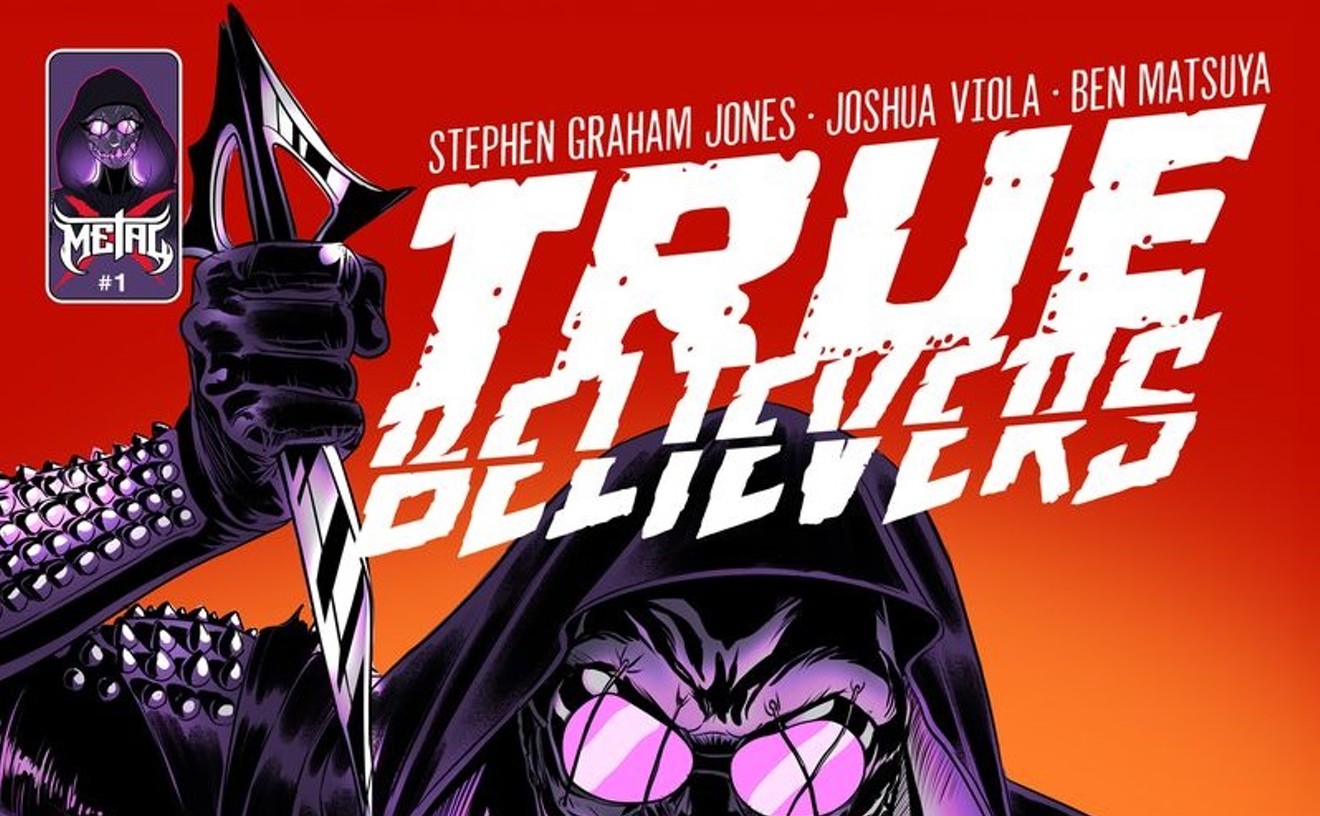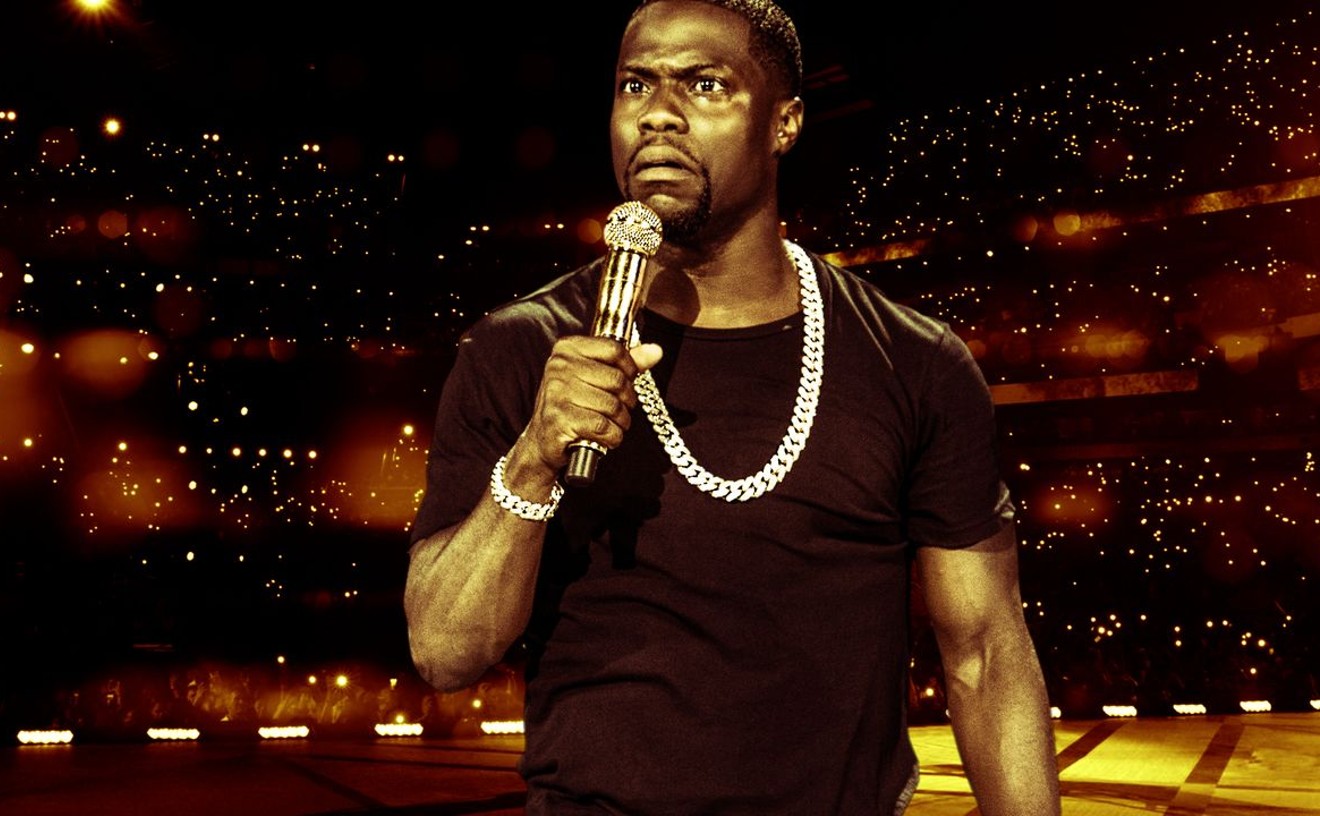Jae Ko's remarkable wall-hung sculptures are up first. Ko is a Korean-born artist who lives in Washington, D.C., and this is the second time Robischon has given her a solo. The mood of the show is austere, but Ko's pieces, though severe-looking, are sumptuous. At first it's unclear what the sculptures are made of, but that's because Ko uses something very strange: adding-machine tape.
Ko buys rolls of the tape, an almost worthless surplus material from a now-archaic technology, and infuses them with color by submerging them in a tub filled with sumi ink. She then shapes individual pieces by pushing and pulling the multiple layers into unified and iconic shapes evocative of nature.
Four Kos have been hung on the wall facing the entrance. They are, from left to right, "JK 224," "JK 204," "JK 216" and "JK 215," and they're installed in such a way as to make them look like parts of a single piece instead of a quartet of singles. Each is a monochrome of a deep, rich tone that results from the infusion process. Most of the Ko sculptures are symmetrical, but sometimes the artist creates complicated maze-like shapes, as in "JK 192."
Ross Bleckner, Terry Maker, Brad Miller, in the center space, was a last-minute addition to the schedule. Despite that, the show is really great, proving beyond any shadow of a doubt that gallery co-directors Jennifer Doran and Jim Robischon are consummate pros.
Bleckner, an internationally known New York-based abstract artist, starts things off with a handful of his famous prints depicting naturalistic shapes in scatter patterns. In "Chaperon," he's laid out an all-over abstraction of light, rounded shapes on a dark background. It looks sort of like a view of the celestial heavens -- something Bleckner has been perfecting for decades. To the left of "Chaperon" is a very different kind of image, an awkwardly balanced arrangement of shapes suggesting flowers or seed heads.
Next comes the work of Maker. The northern Colorado artist is represented in this exhibit by only a handful of pieces, but it's just enough to give viewers a genuine taste of her very distinctive approach. The most ambitious Maker is a large, vertically oriented panel titled "Studio Scene #5 (Striated)," which has a soft, fuzzy surface that resembles a woolen tapestry. On closer inspection, you can easily see that it's not made of cloth, but, as with the Kos, it's hard to tell what the material might actually be until it's explained.
Surprisingly, the Makers are done in that most ubiquitous of all painting processes: acrylic on canvas. But that's only a small part of the story. Maker begins by covering strips of canvas with paint, then rolling the strips into tight coils that are glued together into big, solid blocks. Maker cuts the resulting mass into thin slices with power tools, then arranges the slices into simple compositions. Her palette is particularly nice, made up of both creamy and dusty earth tones. The delicately colored shades are made even more precious by the surface's fragmentized quality, which was created by the saw blades piercing through the fabric and paint.
Brad Miller, the last in this trio of artists, spent a long time in Colorado before relocating to California a few years ago. He is best known as a ceramic artist, and the show includes a small assortment of his heavily modeled bowls, which are absolutely stunning in form and color. But the main attraction here is not his pottery; it's a lyrical group of artworks that could be called drawings except for one little thing: the way they were made. Miller used a torch instead of a pencil, burning naturalistic patterns into the surface of plywood boards and sheets of thick rag paper.
I liked the Millers, but clearly, the burning method, which links these pieces conceptually to his ceramics, is better when applied to wood than to paper. Wood burns less quickly than paper, allowing Miller to better control the results. The imagery he conjures up in these works is inspired by natural forms -- in particular, leaves, as in "Different Way, #1."
The cavalcade of hits continues in the Viewing Room, where Judy Pfaff is ensconced. From a size perspective, Judy Pfaff is modest, but from the perspective of quality, it's surely one of the most significant shows in town. This intimate exhibit includes the elaborate works on paper that the highly respected New York artist has been doing over the past few years. Pfaff came to the fore in the 1970s, when her zany, more-is-more installations took the international art world by storm. Three decades later, she's still mega-famous, with a monograph on her work having just come out. The book, which is on display at Robischon, was written by no less a modern-art authority than the legendary Irving Sandler, a genuine scholar's scholar.
The Pfaffs at Robischon combine found imagery -- photos, maps and charts -- with handmade drawn elements, some of which are done with colored waxes. The tissue-thin papers on which the images are applied are transparent or translucent, so that images on the lower layers "bleed" through to the top layers and appear as ghostly, vaporous marks. The imagery Pfaff prefers is rife with naturalistic things, especially leaves, but there are also a lot of straight lines and other things that look mechanized. And even though many of the objects depicted are recognizable, the overall effect is essentially abstract.
The drawings have been arranged in groupings in which compatible works are notched into one another like pieces of a jigsaw puzzle. This approach nicely reflects Pfaff's history as a pioneering installation artist. Another interesting feature of these pieces are the drawn and painted elements on the artist-made frames, literally allowing Pfaff's imagery to extend beyond the margins of the papers and onto the walls.
Rarely do I see two shows in the same place that work well together; to find three complementary ones is virtually unheard of. The two solos, Jae Ko and Judy Pfaff, and the group effort, Ross Bleckner, Terry Maker, Brad Miller, are the kind of rare pleasures that absolutely no one interested in contemporary art in Denver should consider passing up.
The Rocky Mountain College of Art and Design has produced more than its share of notable local artists during the past several years. There are a whole slew of them making big contributions to the ongoing vitality of Denver's contemporary-art scene. The list of RMCAD alums who've made names for themselves, based wholly on the high quality of their work, include Bruce Price, Bryan Andrews, Mary Ehrin, Karen McClanahan, John Morrison, David Mazza, Warren Kelly, Zack Smith, Jonathan Stiles, Michelle Gonzales, Colin Livingston, Addrienne Amato, Jason Patz and a half-dozen others. It's an impressive track record, especially when compared with other colleges and universities in the region.
In spite of these glittering successes, RMCAD's immediate future is starting to look pretty dim. The word is out all over town about the problem: Stephen Sumner, the new president of the college.
Sumner got the top job at RMCAD in the spring of 2003 and came on during the summer. Over the past several years, he's been quite the gadabout. Before taking the helm at RMCAD, he was provost for less than two years at the New World School of the Arts, a high school in Florida; prior to that, he taught at the University of Tulsa.
Sumner is very formal, which puts him at odds with the very informal art world. For one, he's made it known that he wants the men on the faculty to start wearing ties. For another, he wants to be addressed by employees and students alike as "Mr. President." (No, I am not making this up.)
More serious than these gaffes is the way he has demoralized the people who work there. He's been unable to develop a meaningful rapport with most of the faculty and staff -- you know, the folks who are responsible for RMCAD's success. Sumner served notice to all that they needed to watch their step when he forced RMCAD's popular provost, Neal King, to resign two weeks ago. In an all-campus meeting on Thursday, January 8, the news was announced to the stunned crowd, with no explanation. The next day, Sumner gave the dispirited employees what could be called a reverse pep talk, telling them that "things need to change" and that he "plays hardball." Implicit in his remarks is that if staff members don't do what they're told, heads will roll. (Gee, I know whose head I'd roll if I were in charge.)
I have many fond memories of teaching classes at RMCAD between 1999 and last year. (This period predates the Sumnerian era.) When I was there, Steven Steele -- he wanted everyone to call him "Steve" -- was the president. The accessible Steele spent his entire adult life treating RMCAD like a treasured family heirloom, which is what it is to him: His father, Philip, founded the school more than forty years ago.
Stay tuned. Hopefully, for the sake of the art community and the well-being of the people who work there, RMCAD will flourish once again. But only if Sumner can be convinced to stop shooting himself in the foot. Or, failing that, do what he's done many times before: Go out and find some other job.










